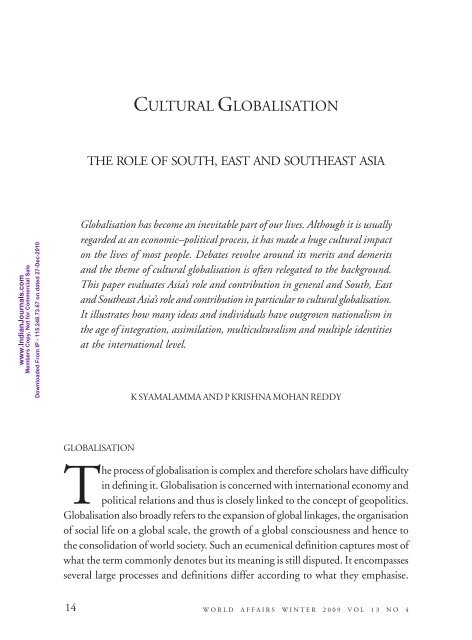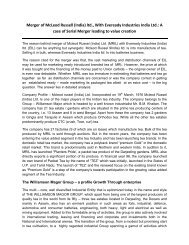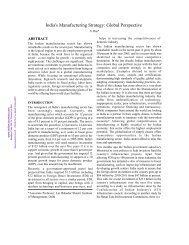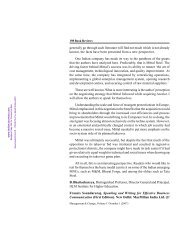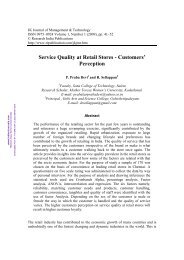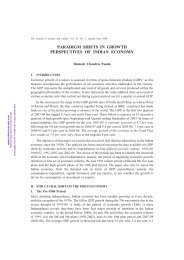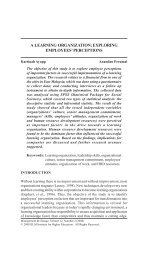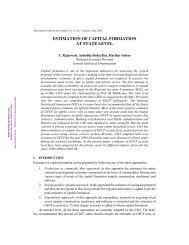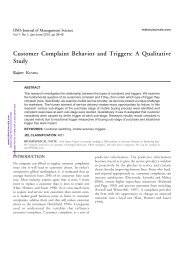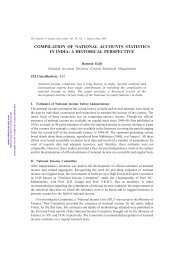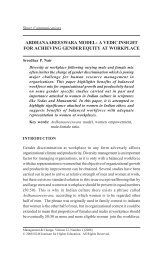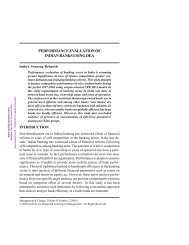Cultural Globalisation - Mimts.org
Cultural Globalisation - Mimts.org
Cultural Globalisation - Mimts.org
Create successful ePaper yourself
Turn your PDF publications into a flip-book with our unique Google optimized e-Paper software.
CULTURAL GLOBALISATION<br />
THE ROLE OF SOUTH, EAST AND SOUTHEAST ASIA<br />
www.IndianJournals.com<br />
Members Copy, Not for Commercial Sale<br />
Downloaded From IP - 115.248.73.67 on dated 27-Dec-2010<br />
<strong>Globalisation</strong> has become an inevitable part of our lives. Although it is usually<br />
regarded as an economic–political process, it has made a huge cultural impact<br />
on the lives of most people. Debates revolve around its merits and demerits<br />
and the theme of cultural globalisation is often relegated to the background.<br />
This paper evaluates Asia’s role and contribution in general and South, East<br />
and Southeast Asia’s role and contribution in particular to cultural globalisation.<br />
It illustrates how many ideas and individuals have outgrown nationalism in<br />
the age of integration, assimilation, multiculturalism and multiple identities<br />
at the international level.<br />
K SYAMALAMMA AND P KRISHNA MOHAN REDDY<br />
GLOBALISATION<br />
The process of globalisation is complex and therefore scholars have difficulty<br />
in defining it. <strong>Globalisation</strong> is concerned with international economy and<br />
political relations and thus is closely linked to the concept of geopolitics.<br />
<strong>Globalisation</strong> also broadly refers to the expansion of global linkages, the <strong>org</strong>anisation<br />
of social life on a global scale, the growth of a global consciousness and hence to<br />
the consolidation of world society. Such an ecumenical definition captures most of<br />
what the term commonly denotes but its meaning is still disputed. It encompasses<br />
several large processes and definitions differ according to what they emphasise.<br />
14<br />
WORLD AFFAIRS WINTER 2009 VOL 13 NO 4
CULTURAL GLOBALISATION: THE ROLE OF SOUTH, EAST AND SOUTHEAST ASIA<br />
www.IndianJournals.com<br />
Members Copy, Not for Commercial Sale<br />
Downloaded From IP - 115.248.73.67 on dated 27-Dec-2010<br />
<strong>Globalisation</strong> is historically complex and its connotations vary in the particular<br />
driving force they identify. The meaning of the term itself is a topic of discussion.<br />
It may refer to “real” processes, to ideas that justify them or to a way of thinking<br />
about them. The term is not neutral and its definitions express different assessments<br />
of global change (available at, http://www.sociology.emory.edu). Some definitions,<br />
related to cultural globalisation are given below.<br />
• “The compression of the world and the intensification of consciousness of the<br />
world as a whole … concrete global interdependence and consciousness of the<br />
global whole in the twentieth century” (Roland Robertson, Globalization Social<br />
Theory and Culture, London: Sage Publications, 1992, p 8).<br />
• “A social process in which the constraints of geography on social and cultural<br />
arrangements recede and in which people become increasingly aware that they<br />
are receding” (Malcolm Waters, Globalization, London: Routledge, 1995, p3).<br />
• “The historical transformation constituted by the sum of particular forms and<br />
instances of … (m)aking or being made global (i) by the active dissemination<br />
of practices, values, technology and other human products throughout the<br />
globe (ii) when global practices and so on exercise an increasing influence over<br />
people’s lives (iii) when the globe serves as a focus for, or a premise in, shaping<br />
human activities” (Martin Albrow, The Global Age State and Society Beyond<br />
Modernity, Stanford: Stanford University Press, 1996, p 88).<br />
• “As experienced from below, the dominant form of globalisation means a<br />
historical transformation: in the economy, of livelihoods and modes of<br />
existence; in politics, a loss in the degree of control exercised locally … and in<br />
culture, a devaluation of a collectivity’s achievements … <strong>Globalisation</strong> is<br />
emerging as a political response to the expansion of market power … (It) is a<br />
domain of knowledge” (James H Mittelman, The Globalization Syndrome:<br />
Transformation and Resistance, Princeton: Princeton University Press, 2000, p 6).<br />
HISTORICAL BACKGROUND<br />
Nayan Chanda (Bound Together: How Traders, Preachers, Adventurers and<br />
Warriors Shaped <strong>Globalisation</strong>, New Delhi: Penguin-Viking, 2008) moving<br />
back and forth through space and time points out the global nature of human<br />
VOL 13 NO 4 WINTER 2009 WORLD AFFAIRS 15
K SYAMALAMMA AND P KRISHNA MOHAN REDDY<br />
www.IndianJournals.com<br />
Members Copy, Not for Commercial Sale<br />
Downloaded From IP - 115.248.73.67 on dated 27-Dec-2010<br />
interaction since time immemorial. According to him, from cotton and spices to<br />
sugar and slaves, Buddhism and Christianity to Islam and human rights, the<br />
movement of goods and humans across lands and seas also led to the migration of<br />
culture, ideas, religion and technology. In every historical period, some forces<br />
contested this movement or benefited from it but the inevitability of human<br />
<strong>Globalisation</strong> is concerned with<br />
international economy and<br />
political relations and thus is<br />
closely linked to the concept of<br />
geopolitics. <strong>Globalisation</strong> also<br />
broadly refers to the expansion<br />
of global linkages, the<br />
<strong>org</strong>anisation of social life on a<br />
global scale, the growth of a<br />
global consciousness and hence<br />
to the consolidation of world<br />
society.<br />
interaction triumphed over all attempts<br />
to close off societies from outside<br />
influence. Chanda traces the process of<br />
globalisation from the eighth<br />
millennium BC. In his analysis,<br />
throughout history four broad agents—<br />
traders, preachers, adventurers and<br />
warriors—have played important roles<br />
in globalisation. Throughout the early<br />
medieval period, trade between<br />
countries of the East and West<br />
engendered the idea to slowly globalise<br />
the world. Geographical discoveries, the<br />
consequential European trade and the<br />
process of colonisation paved the way for vigorous globalisation, while the Industrial<br />
Revolution accelerated its pace. Between 1800 and 1913, international trade grew<br />
rapidly from 29 to 64 per cent. The 1990s were a crucial period in the stages of<br />
globalisation, as the collapse of the Soviet Union and Eastern European communism<br />
and the end of the Cold War coincided with “free trade, liberalisation (and) the<br />
opening up of economies” in almost all parts of the globe.<br />
CULTURAL GLOBALISATION<br />
Webster’s Third New International Dictionary defines culture as the “total pattern<br />
of human behaviour and its products embodied in speech, action and<br />
artefacts and dependent upon man’s capacity for learning and transmitting knowledge<br />
to succeeding generations”. Moreover, culture is not static, it grows out of a<br />
systematically encouraged reverence for select customs and habits. Language, political<br />
16<br />
WORLD AFFAIRS WINTER 2009 VOL 13 NO 4
CULTURAL GLOBALISATION: THE ROLE OF SOUTH, EAST AND SOUTHEAST ASIA<br />
www.IndianJournals.com<br />
Members Copy, Not for Commercial Sale<br />
Downloaded From IP - 115.248.73.67 on dated 27-Dec-2010<br />
and legal systems, religion and social customs are the legacies of victors and marketers<br />
and reflect the judgment of the marketplace of ideas throughout popular history.<br />
“They might also rightly be seen as living artefacts, bits and pieces carried forward<br />
through the years on currents of indoctrination, popular acceptance and unthinking<br />
adherence to old ways. Culture is used by the <strong>org</strong>anisers of society—academics,<br />
families, politicians and theologians—to impose and ensure order, the rudiments<br />
of which change over time as need dictates”. Britannica Online defines cultural<br />
globalisation as “a phenomenon by which the experience of everyday life, as<br />
influenced by the diffusion of commodities and ideas, reflects a standardisation of<br />
cultural expressions around the world. Propelled by the efficiency and appeal of<br />
wireless communications, electronic commerce, popular culture and international<br />
travel, globalisation has been seen as a trend toward homogeneity that will eventually<br />
make human experience everywhere essentially the same. This appears, however, to<br />
be an overstatement of the<br />
phenomenon. Although homogenising<br />
influences do indeed exist, they are far<br />
from creating anything akin to a single<br />
world culture”.<br />
In 1997, David Rothkopf (“In Praise<br />
of <strong>Cultural</strong> Imperialism? Effects of<br />
Globalization on Culture”, available at,<br />
http://www.globalpolicy.<strong>org</strong>) noted<br />
that while globalisation has economic<br />
roots and political consequences, it also<br />
brings into focus the power of culture<br />
Culture grows out of a<br />
systematically encouraged<br />
reverence for select customs and<br />
habits. Language, political and<br />
legal systems, religion and social<br />
customs are the legacies of<br />
victors and marketeers and reflect<br />
the judgment of the marketplace<br />
of ideas throughout popular<br />
history.<br />
in the global environment. “The homogenising influences of globalisation that are<br />
most often condemned by the new nationalists and by cultural romanticists are<br />
actually positive; globalisation promotes integration and the removal not only of<br />
cultural barriers but of many of the negative dimensions of culture”. Critics of<br />
globalisation argue the process will strip away identity and lead to a blandly uniform,<br />
Orwellian world. This, however, is an impossibility on a planet of over six billion<br />
people. More importantly, the decline of cultural distinctions may be a measure of<br />
the progress of civilisation, a tangible sign of enhanced communications and<br />
VOL 13 NO 4 WINTER 2009 WORLD AFFAIRS 17
K SYAMALAMMA AND P KRISHNA MOHAN REDDY<br />
www.IndianJournals.com<br />
Members Copy, Not for Commercial Sale<br />
Downloaded From IP - 115.248.73.67 on dated 27-Dec-2010<br />
understanding. Successful multicultural societies, be they nations, federations or<br />
other conglomerations of closely interrelated states, discern those aspects of culture<br />
that do not threaten prosperity, stability or union (such as food, holidays, music<br />
and rituals) and allow them to flourish. Nevertheless, they do counteract or eradicate<br />
the more subversive elements of culture (exclusionary aspects of language, political–<br />
ideological beliefs and religion). Rothkopf added that history has shown that to<br />
bridge cultural gaps successfully and serve as a home to diverse people, society<br />
requires certain social institutions, laws and structures that transcend culture.<br />
Furthermore, the history of a number of ongoing experiments in multiculturalism,<br />
such as in the European Union, India, South Africa and the United States (US),<br />
suggests that workable, if not perfected, integrative models do exist.<br />
Current trends that fall under the broad definitional umbrella of globalisation<br />
are accelerating a process that has taken place throughout history as discrete groups<br />
become familiar with one another, ally and commingle—ultimately becoming more<br />
alike. The drivers of today’s rapid globalisation are improving methods and systems<br />
of international transportation, revolutionary and innovative information<br />
Successful multicultural societies<br />
discern those aspects of culture<br />
that do not threaten prosperity,<br />
stability or union (such as food,<br />
holidays, music and rituals) and<br />
allow them to flourish.<br />
Nevertheless, they do counteract<br />
or eradicate the more subversive<br />
elements of culture (exclusionary<br />
aspects of language, political–<br />
ideological beliefs and religion).<br />
technologies and services and<br />
dominating international commerce in<br />
services and ideas. Their impacts affect<br />
language, lifestyles, religion and almost<br />
every other component of culture.<br />
Technology today is not only<br />
transforming the world, it is creating its<br />
own metaphors as well. Satellites<br />
carrying television signals expose people<br />
on opposite sides of the globe to a wide<br />
range of cultural stimuli (ibid). The US<br />
is seen as dominating this global traffic<br />
in ideas and information—American<br />
movies, music, software and television are so dominant, so sought after and so<br />
visible that they are now available literally everywhere on the Earth. They influence<br />
the aspirations, lives and tastes of virtually every nation, although in some, they are<br />
viewed as corrupting (ibid). It is however, difficult to agree with this viewpoint,<br />
18<br />
WORLD AFFAIRS WINTER 2009 VOL 13 NO 4
CULTURAL GLOBALISATION: THE ROLE OF SOUTH, EAST AND SOUTHEAST ASIA<br />
www.IndianJournals.com<br />
Members Copy, Not for Commercial Sale<br />
Downloaded From IP - 115.248.73.67 on dated 27-Dec-2010<br />
because as technology creates its own metaphors and transforms the world, people<br />
are exposed to a wide range of cultural stimuli. It would thus be incorrect to say<br />
that only the US influence is dominating international culture. Much water has<br />
flown since 1997 and the globalisation now taking shape, sends and receives<br />
influences from both the East and West.<br />
It is interesting to note American reaction to this issue. When it comes to<br />
globalisation bringing greater cultural influences into the US, Americans express a<br />
positive attitude. When asked in a January 2004 Program on International Policy<br />
Attitudes (PIPA) poll, to think about “how globalisation has resulted in new ideas<br />
and cultural influences coming into the US from other countries”, 68 per cent<br />
regarded this as a positive development<br />
and only 25 per cent felt the influences<br />
were negative. In May 1999, a Pew poll<br />
found that 71 per cent of Americans<br />
agreed that cultural diversity was a main<br />
reason for America’s success. In a 1998<br />
Yankelovich poll, a near unanimous<br />
majority (91 per cent) agreed, “the<br />
global economy makes it more<br />
important than ever for all of us to<br />
understand people who are different<br />
than ourselves” (available at, http://<br />
www.americans-world.<strong>org</strong>). There are<br />
strong indications that American values<br />
The drivers of today’s rapid<br />
globalisation are improving<br />
methods and systems of<br />
international transportation,<br />
revolutionary and innovative<br />
information technologies and<br />
services and dominating<br />
international commerce in<br />
services and ideas. Their impacts<br />
affect language, lifestyles,<br />
religion and almost every other<br />
component of culture.<br />
operate in a global context and that the sphere of concern extends beyond national<br />
boundaries. In a PIPA October 1999 poll, 73 per cent agreed (44 per cent strongly)<br />
with the statement, “I regard myself as a citizen of the world as well as a citizen of<br />
the United States” (available at, ibid).<br />
Central to many of the sociological interpretations of globalisation is the notion<br />
of culture and indeed much of the original theorising about globalisation developed<br />
in this quarter (Ian Clark, <strong>Globalisation</strong> and Fragmentation, International Relations<br />
in the Twentieth Century, New York: Oxford University Press, 1997). Robertson<br />
(ibid, p 135) states that globalisation involves “the development of something like<br />
VOL 13 NO 4 WINTER 2009 WORLD AFFAIRS 19
K SYAMALAMMA AND P KRISHNA MOHAN REDDY<br />
www.IndianJournals.com<br />
Members Copy, Not for Commercial Sale<br />
Downloaded From IP - 115.248.73.67 on dated 27-Dec-2010<br />
a global culture”. His perspective emphasises a newfound consciousness as well as<br />
physical compression of the world (ibid, p 8). This of course does not necessarily<br />
mean a uniform and homogenous culture worldwide, as any such claim would be<br />
impossible to sustain (Clark, ibid, p 23). In a more modest version, it implies that<br />
cultures become “relativised” to each other but are not “unified or centralised”<br />
(Waters, ibid, pp 125–6). Thus, cultural globalisation may be regarded as “unity in<br />
The expansion of Europe<br />
brought about the economic and<br />
technological unification of the<br />
globe and European-dominated<br />
international society of the<br />
nineteenth and early twentieth<br />
centuries first expressed its<br />
political unification. During the<br />
world wars however, a deeper<br />
and more widespread process of<br />
cultural Americanization was<br />
accelerated.<br />
diversity”. Clark also points to the<br />
diversity of views and perceptions of<br />
globalisation, differentiates five<br />
interpretations of globalisation (Waters,<br />
ibid, p 24) and his first school partly<br />
focuses on cultural globalisation.<br />
According to him, globalisation has<br />
been shaped by the major international<br />
trend of the past several centuries namely<br />
Westernisation. That is, Europe’s<br />
economic and military incorporation of<br />
the world created the precondition of<br />
an integrated global system. Hedley Bull<br />
and Adam Watson (Eds, The Expansion<br />
of International Society, New York: Oxford University Press, 1984) opine that “it<br />
was the expansion of Europe that first brought about the economic and<br />
technological unification of the globe (and) it was the European dominated<br />
international society of the nineteenth and early twentieth centuries that first expressed<br />
its political unification”. Historically, this had been true since the era of<br />
industrialisation and colonisation, as the rest of the world was influenced by<br />
European culture.<br />
During the world wars however, a deeper and more widespread process of cultural<br />
Americanization was accelerated. As Akira Iriye (“The Globalizing of America 1913–<br />
1945”, The Cambridge History of American Foreign Relations, Vol III, Cambridge:<br />
Cambridge University Press, 1993, p 113) points out, “America … was more than<br />
ever before the symbol of the new material and popular culture”. The automobile,<br />
the motion picture and the radio were the instruments of this process. As a result<br />
20<br />
WORLD AFFAIRS WINTER 2009 VOL 13 NO 4
CULTURAL GLOBALISATION: THE ROLE OF SOUTH, EAST AND SOUTHEAST ASIA<br />
www.IndianJournals.com<br />
Members Copy, Not for Commercial Sale<br />
Downloaded From IP - 115.248.73.67 on dated 27-Dec-2010<br />
of their spread during this period, there was “a cultural Americanization of the<br />
world during the 1920s … (the beginnings of a) … global cultural order” (ibid, p<br />
115). Clark (ibid, p 91) however, states, “… there is a superficial validity to this<br />
picture but it is much overdrawn. Whatever impact all this might have had in<br />
metropolitan Europe, segments of Latin America and pockets of Asia, it is to be<br />
doubted that the vast majority of (the) world’s population was even aware of these<br />
new developments, let alone culturally assimilated by them”. This paper, however,<br />
does not deal with the sociology of globalisation (Dominique Martin, Jean-Luc<br />
Metzger and Philippe Pierre, “The Sociology of Globalization: Theoretical and<br />
Methodological Reflections”, International Sociology, Vol 21, No 4, 2006, pp 499–<br />
521) or the globalisation of the visual arts as dealt with by Alain Quemin<br />
(“Globalization and Mixing in the Visual Arts: An Empirical Survey of ‘High<br />
Culture’ and Globalization”, International Sociology, ibid, pp 522–50). Though<br />
some scholars believe the world has become unipolar, others think it is multipolar<br />
in terms of trade, defence, etc (James Leigh, “Post-<strong>Globalisation</strong>: The Asian<br />
Superpower in the Making”, World Affairs, Vol 10, No 2, 2006, pp 14–35). The<br />
principle of multipolarity can also be applied to cultural globalisation in the sense<br />
that the US is not alone in culturally globalising the world. The “Americanization”<br />
of culture throughout the globe, as believed by a majority of people, is true only to<br />
an extent, as shown by an in-depth analysis.<br />
The history of civilisation reveals that the phenomenon of the globalisation of<br />
civilisation has existed for long. In most cases it developed independently, unlike in<br />
the modern age where some centres have influenced civilisations all over. For example,<br />
during the Stone Age, Palaeolithic, Mesolithic or Neolithic cultures were present<br />
all over the world and though they were uniform, they rarely influenced each other.<br />
Some scholars believe that ideas “fly”. As such, initially civilisations like the Chinese,<br />
Egyptian, Indus and Sumerian flourished in select pockets, while parts of Africa<br />
and America remained Stone Age cultures. However later, many ideas from pottery<br />
to bricks, etc were globalised, that too without an <strong>org</strong>anisation like the World<br />
Trade Organization (WTO). Therefore, the phenomenon of globalisation in nature<br />
and civilisation is not new. Moreover, globalisation had already occurred on the<br />
level of “lifestyles”. The hypothesis is that industrialisation and colonisation made<br />
people’s lifestyles all over the globe similar, if not the same. From agriculture,<br />
VOL 13 NO 4 WINTER 2009 WORLD AFFAIRS 21
K SYAMALAMMA AND P KRISHNA MOHAN REDDY<br />
cooking, electricity, fuel, the production of food grains and transport to household<br />
and kitchen articles, that is, almost all articles used by people around the world<br />
were introduced by Europe. In essence, this may be called “Europeanization”, though<br />
it is truly globalisation. Today, in almost every city, town or even village in Africa,<br />
Asia or South America, in most homes, offices or even agricultural fields, little is<br />
left in terms of lifestyles, which is not European or Western. Most f<strong>org</strong>et that<br />
though the US today is steering globalisation and the process of globalising, it<br />
obtained most of its lifestyle goods from Europe. In this sense, Europe has already<br />
globalised the entire world, including the US.<br />
www.IndianJournals.com<br />
Members Copy, Not for Commercial Sale<br />
Downloaded From IP - 115.248.73.67 on dated 27-Dec-2010<br />
<strong>Cultural</strong> <strong>Globalisation</strong> and Asia<br />
<strong>Globalisation</strong> is generally understood in terms of the movement of goods and<br />
services that is, in terms of trade. In the last two decades as various agreements have<br />
been signed in world trading <strong>org</strong>anisations, a genuine globalisation has taken place.<br />
However, this process of globalisation started and has been sustained in a few “nuclear<br />
centres” of the world. Former Indian External Affairs Minister Pranab Mukherjee<br />
(The Hindu, March 18, 2007) described this feature as the “centre of gravity” in<br />
After the advent of colonisation,<br />
Africa and Asia were made to<br />
serve the interests of European<br />
colonial powers, either as<br />
suppliers of raw materials and<br />
finished goods or as markets for<br />
European products. The<br />
Industrial Revolution globalised<br />
world production and trade.<br />
the global economy. He said that the<br />
global economy was undergoing a shift<br />
in its centre of gravity from Europe and<br />
North America to Asia for the first time<br />
in 350 years. Historically speaking this<br />
feature has been present since the times<br />
of the Egyptian and Indus civilisations.<br />
Around 500 BC for instance, the centres<br />
of gravity were parts of Africa and<br />
Europe and the whole of Asia. The<br />
former two were dependent on the latter<br />
for certain goods like spices, silk, etc and in turn served as its markets. This trend<br />
continued until the fourteenth and fifteenth centuries. After the advent of<br />
colonisation, Africa and Asia were made to serve the interests of European colonial<br />
powers, either as suppliers of raw materials and finished goods or as markets for<br />
22<br />
WORLD AFFAIRS WINTER 2009 VOL 13 NO 4
CULTURAL GLOBALISATION: THE ROLE OF SOUTH, EAST AND SOUTHEAST ASIA<br />
www.IndianJournals.com<br />
Members Copy, Not for Commercial Sale<br />
Downloaded From IP - 115.248.73.67 on dated 27-Dec-2010<br />
European products. The Industrial Revolution globalised world production and<br />
trade. During this phase, the centres of gravity played significant and dominating<br />
roles in production, distribution and as markets and paved the way for globalisation.<br />
For example, although France and Germany did produce certain goods, England<br />
accounted for the bulk of mechanised<br />
and industrial goods and dominated as<br />
the single nuclear centre. This in turn<br />
affected and shaped, directly or<br />
indirectly, world trade throughout<br />
Africa, Asia, Europe and North America.<br />
Later, especially after the world wars and<br />
increasingly since the 1970s, the US has<br />
become the nuclear centre of<br />
Asian business powers have been<br />
taking over Western businesses.<br />
This is a turning point in current<br />
world history and these<br />
takeovers have become symbols<br />
of Asia’s participation in “reverse”<br />
globalisation including culture.<br />
globalisation. As both a producer and market for almost all goods, the US has<br />
played a dominant role in globalisation. As the dominance of England, France and<br />
Germany faded, they ceased to be nuclear centres.<br />
In the last two decades, Asia in general and India and China in particular have<br />
become nuclear centres, as they develop into both primary production centres as<br />
well as markets for world goods. The Ambanis, Birlas, Mittals, Tatas and<br />
information technology (IT) company moghuls have bought, collaborated or taken<br />
over Western business empires ranging from oil to steel to IT industries. Other<br />
Asian business powers like China, Japan, Korea, Taiwan, have been taking over<br />
Western businesses as well. This is indeed a turning point in current world history<br />
and these takeovers have become symbols of Asia’s participation in “reverse”<br />
globalisation including culture as denoted by not only the products but also in the<br />
names of companies like ArcelorMittal Steel. Today, China boasts a world-class<br />
stadium—the Bird’s Nest—an architectural marvel that hosted the 2008 Olympic<br />
Games. This stadium is comparable to any in the West (perhaps it is even better)<br />
and stands as a new symbol of the East in Western minds.<br />
In such a scenario, cultural globalisation is often ignored even as elements like<br />
art, film, food, literature, media, music, painting, sports, are spread throughout<br />
the globe and popularised as global culture. In this process, nuclear centres change,<br />
as “receivers” become “senders”. Yoshitaka Miike (“<strong>Cultural</strong> Asia in the Age of<br />
VOL 13 NO 4 WINTER 2009 WORLD AFFAIRS 23
K SYAMALAMMA AND P KRISHNA MOHAN REDDY<br />
www.IndianJournals.com<br />
Members Copy, Not for Commercial Sale<br />
Downloaded From IP - 115.248.73.67 on dated 27-Dec-2010<br />
Globalization”, Jen Hu Chang, Guo-Ming Chen, D Ray Heisey, Yoshitaka Miike,<br />
Todd Nesbitt, Carmen de la Peza, Jan Servaes and Xu Shi, “Intercultural Symposium<br />
on <strong>Cultural</strong> Globalization”, China Media Research, Vol 2, No 3, 2006) explains<br />
that “<strong>Globalisation</strong> is often perceived in the Asian context as an inevitable process<br />
of adjustment and accommodation. It usually implies the existence of certain global<br />
trends that we need to cope with for survival and success. And such global forces,<br />
<strong>Cultural</strong> globalisation should be<br />
seen as the continual<br />
development of multiple<br />
modernities on a global scale.<br />
Transculturation should develop<br />
so that different cultures can be<br />
true to their own indigenous<br />
strengths and not be swept into<br />
a similar pattern of only one<br />
type of transformation.<br />
or waves of change, come largely from<br />
the West, notably from the United<br />
States. ... We ought to dispel the<br />
misconception of globalisation as<br />
intercultural adaptation to the West. We<br />
should realise that the significance of<br />
globalisation, cultural globalisation in<br />
particular, lies not in the power of<br />
dominance and imposition but in the<br />
possibility of creativity and interaction.<br />
In the Asian milieu, then, is it<br />
conceivable that we will actively fashion<br />
the globalisation of Asian cultures in quest of Asian collective identities and common<br />
values? … Ceaseless dialogue about the commonality and diversity of Asia will<br />
yield profound insights into the politics of Asian identities, the complexities of<br />
Asianness and the beauty of humanity. The time is ripe for us to rekindle our<br />
interest in the distinct cultural traditions of Asia, re-educate ourselves on Asian<br />
cumulative wisdom, explore the common values of <strong>Cultural</strong> Asia and articulate an<br />
Asian vision of the global village”.<br />
According to D Ray Heisey (“The Meaning and Impact of <strong>Cultural</strong><br />
Globalization”, Chang, et al, ibid) “One of the ways of looking at the problem of<br />
‘critical’ perspective. The ‘liberal’ perspective views cultural globalisation as ‘the<br />
triumph of the market economy’ and the ‘critical’ perspective views it as ‘the<br />
domination by Western or American culture’. Instead, Chan and Ma argue that<br />
cultural globalisation should be seen as ‘the continual development of multiple<br />
modernities on a global scale’. They think that transculturation should develop<br />
around the globe so that different cultures can be true to their own indigenous<br />
24<br />
WORLD AFFAIRS WINTER 2009 VOL 13 NO 4
CULTURAL GLOBALISATION: THE ROLE OF SOUTH, EAST AND SOUTHEAST ASIA<br />
www.IndianJournals.com<br />
Members Copy, Not for Commercial Sale<br />
Downloaded From IP - 115.248.73.67 on dated 27-Dec-2010<br />
strengths and not be swept into a similar pattern of only one type of transformation.<br />
This requires interaction between cultures so that the dialectical processes creatively<br />
combine what is good from other cultures with what is preferred from their own<br />
cultures. Cultures and cultural/political leaders should engage in dialogue so that<br />
creative approaches can be negotiated and cultural identities maintained”.<br />
Historically, Asians have been fascinated by Roman wine and Europeans by<br />
Indian and Chinese clothes. Evidently, art, music, painting, sculpture, were quite<br />
different during the second and third centuries AD. After the Europeans and<br />
especially the British began colonising the world, the first “cultural item” to be<br />
globalised was men’s hairstyle. The European “military haircut” spread all over the<br />
colonies and by the 1950s most traditional men’s hairstyles had disappeared. In the<br />
past two decades, India and China have begun competing with the West in fashion<br />
as a number of their designers have become popular globally and introduced exciting<br />
“East–West” hybrid designs. Indian attires like churidars and Chinese and Southeast<br />
Asian dresses and styles are being blended<br />
with Western styles and designs. This<br />
has resulted in the hybridisation of<br />
fashion and fashion design and a new<br />
wave of “Asian consciousness and<br />
confidence” is sweeping across the West.<br />
Fashion events, exhibitions and shows<br />
of reputed Western clothing companies<br />
have been <strong>org</strong>anised and celebrated in<br />
Asian cities like Hong Kong, Mumbai,<br />
Singapore and Tokyo. In addition, as<br />
After the Europeans and<br />
especially the British began<br />
colonising the world, the first<br />
“cultural item” to be globalised<br />
was men’s hairstyle. The<br />
European “military haircut”<br />
spread all over the colonies and<br />
by the 1950s most traditional<br />
men’s hairstyles had disappeared.<br />
Asian fashion and dress designers have become popular in the West through their<br />
shows and designs, many multinationals have hired them to design “international”<br />
clothes. India and China also already had in place the necessary factories, machinery,<br />
etc. Thus, through this process, the nuclear centres of fashion design, which were<br />
exclusively in the West, have spread to the East and in turn Eastern nuclear centres<br />
have started influencing the West and become global.<br />
Over the past fifteen years, due to the agreements of different trading<br />
<strong>org</strong>anisations, most of the goods that were once produced in Europe or North<br />
VOL 13 NO 4 WINTER 2009 WORLD AFFAIRS 25
K SYAMALAMMA AND P KRISHNA MOHAN REDDY<br />
America are now produced in Asia for the world market. Through the promotion<br />
of cultural globalism, Bangladesh, Cambodia, Indonesia, Sri Lanka, have become<br />
popular as the clothes bought in Europe and North America are produced in these<br />
countries. Thus, through this process, directly or indirectly, Asia is promoting its<br />
own traditional designs and culture.<br />
Cars, Curries and Books<br />
www.IndianJournals.com<br />
Members Copy, Not for Commercial Sale<br />
Downloaded From IP - 115.248.73.67 on dated 27-Dec-2010<br />
During the 1970s and 80s, in Europe and North America the “Japanisation” of<br />
cars, music systems, televisions, watches and a whole range of electronic goods<br />
took place. Honda, Sanyo, Seiko, Sony, Suzuki, Toshiba, Toyota, became household<br />
names. Until this period, Europe and the US were the chief producers of automobiles<br />
and electronic goods. However, during that phase, Japan became the nuclear centre<br />
of production and distribution. Since the 1990s India, China and Southeast Asia<br />
As Asian fashion and dress<br />
designers have become popular<br />
in the West through their shows<br />
and designs, many multinationals<br />
have hired them to design<br />
“international” clothes. Thus,<br />
the nuclear centres of fashion<br />
design, which were exclusively in<br />
the West, have spread to the East<br />
and in turn Eastern nuclear<br />
centres have started influencing<br />
the West and become global.<br />
have become nuclear centres of<br />
production for almost all goods<br />
distributed globally. As a result, Europe<br />
and North America have witnessed a<br />
new awareness of “Asian culture” from<br />
electronic goods to clothes and perfumes<br />
and even relatively small countries like<br />
Bangladesh and Thailand have entered<br />
Western minds culturally. Today, apart<br />
from Hondas and Toyotas, even the<br />
Korean Hyundai or Chinese Kia cars and<br />
other Asian goods have become global.<br />
The West is keenly awaiting the Indian<br />
Nano car, which has become a “global<br />
product” even before its release in foreign markets. Most Westerners are conscious<br />
of the fact that many of the products they buy are “Asian” and have accepted them<br />
as a part of their lives.<br />
While McDonalds and Kentucky Fried Chicken have become increasingly<br />
common in Asian cities, Asian cuisine—Chinese flavours, Indian food and Thai<br />
26<br />
WORLD AFFAIRS WINTER 2009 VOL 13 NO 4
CULTURAL GLOBALISATION: THE ROLE OF SOUTH, EAST AND SOUTHEAST ASIA<br />
www.IndianJournals.com<br />
Members Copy, Not for Commercial Sale<br />
Downloaded From IP - 115.248.73.67 on dated 27-Dec-2010<br />
dishes—has become immensely popular in Europe and North America. For the<br />
past two decades, Asian participation in the food culture of the West has been<br />
increasing. Unlike in the past, Asian restaurants—Cambodian, Chinese, Indian,<br />
Lebanese, Thai,—can be seen today in almost all major cities. This process of reverse<br />
globalisation of food culture during the 1980s has now become permanent due to<br />
the health and nutritional values of Asian<br />
pickles and spices. As Shonali Muthalaly<br />
(“Posh Curry”, The Hindu, March 18,<br />
2007) puts it, from Aberdeen to<br />
Brighton, Indian restaurants have<br />
become popular and made Indian food<br />
a part of the British menu.<br />
In fiction, writers like V S Naipaul<br />
have made remarkable contributions.<br />
Since the 1980s, others like Vikram<br />
Chandra, Shobhaa De, Amitav Ghosh,<br />
Arundhati Roy, Salman Rushdie,<br />
Vikram Seth, Tarun Tejpal, Shashi<br />
Tharoor, Altaf Tyrewala, et al though<br />
Since the 1990s India, China<br />
and Southeast Asia have become<br />
nuclear centres of production for<br />
almost all goods distributed<br />
globally. As a result, Europe and<br />
North America have witnessed a<br />
new awareness of “Asian<br />
culture”. Most Westerners are<br />
conscious of the fact that many<br />
of the products they buy are<br />
“Asian” and have accepted them<br />
as a part of their lives.<br />
Asian, have become global writers. Asian poets have also become global and Bengali,<br />
Chinese, Indonesian and Tamil poetry and fiction are being translated into English,<br />
French, Spanish, and distributed worldwide.<br />
Movies, Masti, Magic<br />
Bollywood has become truly global in the sense that Hindi movies (and even<br />
Tamil and Telugu movies) are being simultaneously released in Africa, Asia, Europe<br />
and North America. Asian actors from Jackie Chan to Jet Lee and Aishwarya Rai<br />
to Sushmita Sen, (the former having become the “queen” of computer screens<br />
throughout the world) have all become global. A R Rahman has become a global<br />
music director and singer with his “English” albums becoming popular in the West.<br />
Reverse globalisation started when Shekhar Kapoor directed the Western movie<br />
Elizabeth in 1998. Although Japanese and other Asian directors were already popular<br />
VOL 13 NO 4 WINTER 2009 WORLD AFFAIRS 27
K SYAMALAMMA AND P KRISHNA MOHAN REDDY<br />
www.IndianJournals.com<br />
Members Copy, Not for Commercial Sale<br />
Downloaded From IP - 115.248.73.67 on dated 27-Dec-2010<br />
and had directed Hollywood movies, Kapoor was a relative unknown in the West<br />
and Elizabeth became a turning point in the history of global cinema. M Night<br />
Shyamalan, an American of Indian origin has become a new symbol of cultural<br />
globalisation, directing stars like Mel Gibson and Bruce Willis in shockingly<br />
unexpected roles. Hollywood actors like Will Smith are eager to have Asian heroines<br />
McDonalds and Kentucky Fried<br />
Chicken have become increasingly<br />
common in Asian cities,<br />
Asian cuisine has become<br />
immensely popular in Europe<br />
and North America. From<br />
Aberdeen to Brighton, Indian<br />
restaurants have become popular<br />
and made Indian food a part of<br />
the British menu.<br />
like Rai in their movies. Another<br />
example of reverse globalisation is the<br />
recent Swiss movie Tandoori Love by<br />
Swiss director Oliver Paulus. It is the<br />
story of an Indian chef falling in love<br />
with a Swiss Miss. Although the film<br />
has an Indian name and songs and dances<br />
à la Bollywood, it is still a Swiss film<br />
(Ziya us Salam, “A Taste of Fondue<br />
Masaala” The Hindu, December 5,<br />
2008). Incidentally, the term tandoori<br />
itself has become globalised as this movie<br />
indicates. Paulus has said he wanted to take all the wonderful elements of music,<br />
song and dance from Bollywood and transport them onto a Swiss ambience. He<br />
added, “India is becoming important in the international market … not just<br />
economically but also culturally, India is huge. More and more people are attracted<br />
to India” (ibid).<br />
The year 2009 was indeed a turning point for world cinema in general and<br />
Asian cinema in particular as British director Danny Boyle’s Slumdog Millionaire<br />
received four Golden Globe awards and eight Academy Awards. It was the first<br />
Bollywood style movie to achieve this feat. Of particular significance was Rahman’s<br />
music score, which won at both awards. The movie is a remarkable example of<br />
cultural globalisation—a South Asian story line, a British director, a South Asian<br />
British hero, a Hollywood ambience and promotion and a world cinema. Thus,<br />
Asian movies and music have slowly become global in terms of world cinema and<br />
will certainly play important roles in future cultural globalisation. As Ge<strong>org</strong>e<br />
Abraham (“A Billion Stories Now”, The Hindu, January 25, 2009) aptly puts it,<br />
“Bollywood movies have their global following, thanks to the countless members<br />
28<br />
WORLD AFFAIRS WINTER 2009 VOL 13 NO 4
CULTURAL GLOBALISATION: THE ROLE OF SOUTH, EAST AND SOUTHEAST ASIA<br />
www.IndianJournals.com<br />
Members Copy, Not for Commercial Sale<br />
Downloaded From IP - 115.248.73.67 on dated 27-Dec-2010<br />
of the diaspora who have carried their love for kitschy, formulae thrillers to wherever<br />
they have gone. It is, however, unusual for a movie to marry the realism of<br />
Hollywood and the fantasy of Bollywood into one of international box office<br />
phenomenon”. Several Asian films are being made in English with Asian–Western<br />
appeal and storyline but global in business and audiences and are paving the way<br />
for cultural globalisation.<br />
In Hollywood, directors like Akira Kurosawa and Hayao Miyazaki (Japan),<br />
Wong Kar-wai (Hong Kong), Tsai Ming-liang (Taipei) have made a mark, as has<br />
Ang Lee (Taiwanese born) with his world renowned movies like Brokeback Mountain,<br />
Crouching Tiger, Hidden Dragon, The Hulk, Sense and Sensibility and The Wedding<br />
Banquet. These directors are as much Hollywood directors as they are Asian.<br />
American audiences may not have boned up on Asian film history but after The<br />
Ring raked in $120 million, Hollywood got a crash course. Studios are now falling<br />
all over themselves to cash in—several Asian hits are being remade with big stars<br />
like Sarah Michelle Gellar and Jennifer Connelly. Mainstream America, if it has<br />
not already, is about to learn that when<br />
it comes to horror movies, Asian<br />
filmmakers are amongst the best. Unlike<br />
the recent wave of slasher and zombie<br />
flicks spooking American audiences,<br />
Asian imports—from filmmakers like<br />
Hideo Nakata (Dark Water and Ringu,<br />
the precursor to The Ring), Takashi<br />
Shimizu (the Ju-On series), Kiyoshi<br />
Reverse globalisation started<br />
when Shekhar Kapoor directed<br />
the Western movie Elizabeth in<br />
1998, though Japanese and<br />
other Asian directors were<br />
already popular and had directed<br />
Hollywood movies.<br />
Kurosawa (Kaïro, about the strange happenings that follow a suicide) and the Pang<br />
brothers (Jian Gui, also known as The Eye, about a blind girl who sees ghosts after<br />
eye surgery)—go for chills over scares, stacking up supernatural themes, haunting<br />
visuals and creepy atmosphere. Films like The Eye and The Ring combine a cultural<br />
background filled with ghosts and the supernatural with themes of revenge,<br />
reincarnation and familial ties (available at, http://www.mtv.com).<br />
A panel of the Association for Asian Studies (AAS) Annual Meeting March<br />
22–25, 2007, examined “the concept of ‘transnational’ and its usage in the studies<br />
of East Asian cinema. ‘Transnational cinema’ or, more specifically the unified ‘East<br />
VOL 13 NO 4 WINTER 2009 WORLD AFFAIRS 29
K SYAMALAMMA AND P KRISHNA MOHAN REDDY<br />
www.IndianJournals.com<br />
Members Copy, Not for Commercial Sale<br />
Downloaded From IP - 115.248.73.67 on dated 27-Dec-2010<br />
Asian cinema’ stands as a convenient example of a shared cultural sphere in the age<br />
of globalisation. Both terms, however, have escaped qualification in terms of their<br />
actual meanings and causalities. Does the expansion in the multinational and multiethnic<br />
production, distribution and consumption of films automatically guarantee<br />
the cinema as transnational?” (Organiser and Chair, Mitsuyo Wada-Marciano,<br />
Carleton University, Canada, “Scrutinizing the Transnational in East Asian Cinema”,<br />
Interarea Session 89, (AAS) Annual Meeting, ibid, available at, http://<br />
www.aasianst.<strong>org</strong>). It must be noted that the transfer—not only of films but also<br />
in other fields—which so far had almost always been from West to East, has now<br />
begun to go in the opposite direction.<br />
European playing cards revolutionised the nature of gambling all over the world<br />
long before modern globalisation. Casinos in Europe and North America have<br />
been the main gambling centres with Las Vegas in the US leading in terms of<br />
revenue. In 2006, the Wynn casino in downtown Macau “outstripped the Vegas<br />
strip itself in gambling revenue” (Pallavi Aiyar, “Postcard from Macau – Neon<br />
Glow”, The Hindu, March 18, 2007).<br />
The concept of tourism until now had been from West to East, with visitors<br />
wanting to see ancient monuments. However, Westerners are now visiting Shanghai<br />
and Singapore more for shopping than for sightseeing, while Easterners with their<br />
growing incomes and self-assuring pride are visiting Europe and North America<br />
for “pleasure travel”. In the coming decade, medical tourism is poised to boom in<br />
Asia, especially in India, as thousands of Americans and Europeans visit every year.<br />
All these trends have started “reverse” tourism. Travel writing had so far been a forte<br />
of Westerners but an increasing number of Asian travel writers and journalists now<br />
have their reviews and reports published in leading Asian newspapers.<br />
Reading and Talking<br />
In the education sector, as thousands of Asian students, especially Indians are<br />
spread all over Europe and North America, a new enthusiasm for “Asian culture”<br />
has begun to compete and blend with “Western culture” resulting in an interesting<br />
“global culture”. As youngsters travel widely between the West and their home<br />
countries, they act as ambassadors and promoters of this global culture. Even former<br />
30<br />
WORLD AFFAIRS WINTER 2009 VOL 13 NO 4
CULTURAL GLOBALISATION: THE ROLE OF SOUTH, EAST AND SOUTHEAST ASIA<br />
www.IndianJournals.com<br />
Members Copy, Not for Commercial Sale<br />
Downloaded From IP - 115.248.73.67 on dated 27-Dec-2010<br />
Indian Cabinet Minister Lalu Prasad Yadav has given lectures to management students<br />
in North America including at Harvard, about the success story of the Indian<br />
Railways. Reverse globalisation indeed!<br />
One reaction to the conventional idea of globalisation, as pointed out by Anne<br />
Pakir, an associate professor at the National University of Singapore, is that English<br />
is “going glocal that is, going global while maintaining local roots”. She sees “glocal<br />
English” as a language with an international status but which also expresses local<br />
identities (Asia Times Online, July 31, 2003). Already, more Asians speak English<br />
than anyone and “Asian English” words multiply every year. For the many who see<br />
this as an intrusion, a destructive force, there may be some solace to be found in the<br />
old Malay saying, “your mouth is your tiger” (ibid). The English language now<br />
accommodates “Indian English”, even Hinglish words in its dictionaries. Asian<br />
immigrants in Europe and North America have also begun to influence “Western<br />
English”, akin to the “colonisation” of English in Asia. South Asian English, Chinese,<br />
Japanese, Korean and Malaysian English can be heard in both usage and accent.<br />
The English language is no longer the<br />
“Whiteman’s language”, especially after<br />
the introduction of internet, chat and<br />
blog English. “As the result of low-cost<br />
airfares, the internet, the hegemony of<br />
the English language and the rise of the<br />
transnational corporation, we’re<br />
increasingly sharing social, cultural,<br />
identity-forming experiences. David<br />
Beckham is no longer British, Nicole<br />
Westerners are now visiting<br />
Shanghai and Singapore more for<br />
shopping than for sightseeing,<br />
while Easterners with their<br />
growing incomes and selfassuring<br />
pride are visiting Europe<br />
and North America for “pleasure<br />
travel”.<br />
Kidman is no longer Australian, McDonalds and Microsoft are no longer American.<br />
The searing memory of the collapse of the twin towers is common to us all”<br />
(available at, http://thetyee.ca).<br />
So far, Westerners including East Europeans and especially Russians had<br />
dominated sports like chess, golf, squash and tennis. However, in the last two<br />
decades Asians like tennis players Leander Paes and Sania Mirza, the Indian chess<br />
grand master Vishwanath Anand, the squash playing Khans of Pakistan, et al have<br />
become global players. An Asian presence is thus being felt in these sports worldwide,<br />
VOL 13 NO 4 WINTER 2009 WORLD AFFAIRS 31
K SYAMALAMMA AND P KRISHNA MOHAN REDDY<br />
while China and Southeast Asia continue to dominate as nuclear centres of<br />
badminton and table tennis.<br />
www.IndianJournals.com<br />
Members Copy, Not for Commercial Sale<br />
Downloaded From IP - 115.248.73.67 on dated 27-Dec-2010<br />
MULTICULTURALISM AND MODERNITY<br />
The ideas of integration and assimilation are being challenged by immigrants<br />
in countries like Australia, Canada and England. The West is slowly coming<br />
to grips with concepts like the multiple identities of immigrants and the transnational<br />
identities of individuals in the global age. These have consequently contributed to<br />
cultural globalisation. In the present day world, the integration perspective has<br />
weakened and that of the subject or individual has become more dominant. Nations<br />
are no longer the sole or even main sources of identification of individuals who are<br />
increasingly associated with multiple identities extending beyond the framework<br />
of countries. Between the local and the supranational, the national level is only one<br />
level amongst others (Michel Wieviorka, “Can the Concept of Integration still<br />
Help Us? State and Civil Society in a Global World”, Sociological Bulletin – Journal<br />
of the Indian Sociological Society, Vol 57, No 1, January–April 2008, pp 30–40).<br />
For example, Singapore, the leading entrepôt of Southeast Asia, is a hub for a<br />
global network of business centres in which the lives of the elites are virtually<br />
identical. Business leaders from Buenos Aires to Frankfurt, Hong Kong, Istanbul,<br />
Johannesburg, Los Angeles, Mexico<br />
One reaction to the conventional City, Moscow, New Delhi, New York,<br />
idea of globalisation, is that Paris, Rome, Santiago, Seoul,<br />
English is going glocal that is, Singapore, Tel Aviv and Tokyo all read<br />
going global while maintaining the same newspapers, wear the same<br />
local roots. Already, more Asians suits, drive the same cars, eat the same<br />
speak English than anyone and food, fly the same airlines, stay in the<br />
“Asian English” words multiply same hotels and listen to the same<br />
every year.<br />
music. While people of divergent<br />
origins remain divided by culture, they<br />
have realised that to compete in the global marketplace they must conform to the<br />
culture of that marketplace. The community of nations has increasingly accepted<br />
that such supranational entities are demanded by the exigencies of the times and<br />
32<br />
WORLD AFFAIRS WINTER 2009 VOL 13 NO 4
CULTURAL GLOBALISATION: THE ROLE OF SOUTH, EAST AND SOUTHEAST ASIA<br />
www.IndianJournals.com<br />
Members Copy, Not for Commercial Sale<br />
Downloaded From IP - 115.248.73.67 on dated 27-Dec-2010<br />
with that acceptance comes the recognition that the principal symbol of national<br />
identity—namely sovereignty—must be partially ceded to those entities. Joana<br />
Breidenbach and Ina Zukrigl (“The Dynamics of <strong>Cultural</strong> <strong>Globalisation</strong>”, The Myths<br />
of <strong>Cultural</strong> <strong>Globalisation</strong>, available at, http://www.inst.at) have given a breathtaking<br />
analysis of multiculturalism in relation to globalisation, identity and nation.<br />
An increasing number of individuals stress their multicultural biographies, from<br />
writers like Salman Rushdie to the golfer Tiger Woods, who calls himself<br />
Cablinasian to point out his ancestry of Black, Indian and Asian cultures. Writers<br />
with a multicultural biography were among the first to express changes called<br />
“creolisation”. Authors like Hanif<br />
Kureishi, Keri Hulme and Emine Sevgi<br />
Özdamar mix languages and express in<br />
their writings the diversity and richness<br />
of their cultural influences as well as the<br />
conflicts that form part of the<br />
creolisation process. In view of this,<br />
“locality” loses its importance as new<br />
transnational communities come into<br />
being. These are bound together by<br />
common interests, professions or social<br />
and cultural similarities rather than by<br />
Nations are no longer the sole or<br />
even main sources of<br />
identification of individuals who<br />
are increasingly associated with<br />
multiple identities extending<br />
beyond the framework of<br />
countries. Between the local and<br />
the supranational, the national<br />
level is only one level amongst<br />
others.<br />
origin or geographical closeness. The more privileged among them are businessmen<br />
and scientists, while the majority are exile communities, migrants and refugees,<br />
who set up long distance communication and economic links and send self-recorded<br />
tapes and commodities back and forth. Both processes, the creolisation of local<br />
societies and the formation of transnational communities, demonstrate the<br />
inadequacy of the concept that sees cultures as bound and static units. <strong>Cultural</strong><br />
change is often conceived of as a “loss” but “culture is not an attribute to be gained<br />
or lost but a process or struggle by which all peoples of the world attempt to make<br />
sense of the world”. The image of the world as a mosaic, consisting of clearly<br />
defined and separated single stones (the cultures) has to give way to the idea of<br />
culture as a flow. The metaphor of cultural flow allows for acknowledging cultural<br />
similarities and differences irrespective of origin and geographical place.<br />
VOL 13 NO 4 WINTER 2009 WORLD AFFAIRS 33
K SYAMALAMMA AND P KRISHNA MOHAN REDDY<br />
www.IndianJournals.com<br />
Members Copy, Not for Commercial Sale<br />
Downloaded From IP - 115.248.73.67 on dated 27-Dec-2010<br />
THE EMERGING GLOBAL CULTURE: ORGANISING CULTURAL DIVERSITY<br />
WORLDWIDE<br />
The emerging global culture consists of universal categories and standards by<br />
which cultural differences become mutually intelligible and compatible.<br />
Societies all over the world are on the one hand becoming more similar to one<br />
another and on the other more disparate. Anthropologist Richard Wilk has termed<br />
this new reference system “structures of common difference”. By this, he is referring<br />
to a new global hegemony, which is the hegemony of structure and not of content.<br />
Global structures <strong>org</strong>anise diversity. While different cultures continue to be distinct<br />
and varied—they are becoming different in uniform ways. Most of the global<br />
categories and standards circulating today originate in the West but spread because<br />
people everywhere appropriate them and use them to express themselves and fight<br />
for their own ends. In the process, the hegemonic structures themselves are<br />
transformed.<br />
Certain ideas, histories and stories (including such diverse ones such as the death<br />
of Lady Diana, the demise of the apartheid regime in South Africa or the<br />
institutionalisation of human rights) are available to an increasing number of people<br />
in most parts of the world. They are distributed mainly through the media and the<br />
millions of people on the move, like businessmen, migrants, refugees and tourists.<br />
People are thus forced to reflect on their<br />
While people of divergent own way of life in the mirror of other<br />
origins remain divided by ways of life. Consequently, many people<br />
culture, they have realised that develop a “comparative consciousness”.<br />
to compete in the global This has the potential of creating a<br />
marketplace they must conform common ground, a kind of lingua franca<br />
to the culture of that for different people all over the world.<br />
marketplace.<br />
It is important to keep in mind that<br />
global culture does not exist in a power<br />
vacuum. Most of the structures and standards circulating today originate in the<br />
West, which makes a sustained effort to assure their survival. However not only are<br />
people from other countries challenging this dominance (like Southeast Asian<br />
intellectuals and politicians) but the diffusion of many Western ideas and institutions,<br />
34<br />
WORLD AFFAIRS WINTER 2009 VOL 13 NO 4
CULTURAL GLOBALISATION: THE ROLE OF SOUTH, EAST AND SOUTHEAST ASIA<br />
www.IndianJournals.com<br />
Members Copy, Not for Commercial Sale<br />
Downloaded From IP - 115.248.73.67 on dated 27-Dec-2010<br />
after successful appropriation, makes the origin of concepts and ideas increasingly<br />
irrelevant. A dialogue on cultural differences and similarities has been forced upon<br />
Western societies as they themselves undergo an immense internal process of<br />
pluralisation and become increasingly multicultural. Identity politics and cultural<br />
differences are no longer problems somewhere else but in one’s own neighbourhood.<br />
<strong>Cultural</strong> differences have to be confronted head on and as such, dialogue and new<br />
forms of conflict resolution are inevitable. It is unlikely that the structures of the<br />
global culture will remain unchanged after sustained dialogue (Breidenbach and<br />
Zukrigl, ibid).<br />
Thus, the phenomenon of globalisation has long been present in nature and<br />
civilisation. The current trend points to the formation and acceptance of cultural<br />
diversity on a global scale, which had hitherto been on a national scale. Hence, the<br />
broad Asian and Western cultures are on the one hand meeting and combining to<br />
create a hybrid global culture and on the<br />
other, in the process are losing some<br />
features while adding others on both<br />
sides. The global and local are mixing<br />
and remixing and have led to the<br />
creation of glocal, which is in essence,<br />
cultural globalisation. Therefore, global<br />
culture has become simultaneously more<br />
diverse and more alike. While some<br />
features fall into natural globalisation<br />
with no conscious or deliberate attempts<br />
by groups of people, nations or<br />
<strong>org</strong>anisations, others, like treaties and<br />
Both the creolisation of local<br />
societies and the formation of<br />
transnational communities,<br />
demonstrate the inadequacy of<br />
the concept that sees cultures as<br />
bound and static units. The<br />
image of the world as a mosaic,<br />
consisting of clearly defined and<br />
separated single stones has to<br />
give way to the idea of culture as<br />
a flow.<br />
<strong>org</strong>anisations like the WTO, World Bank and International Monetary Fund fall<br />
into the category of “artificial” globalisation agents. Lifestyle, a part of culture, has<br />
become global without notice, awareness or even attempt and Asia has started<br />
playing a significant role in cultural globalisation.<br />
VOL 13 NO 4 WINTER 2009 WORLD AFFAIRS 35


